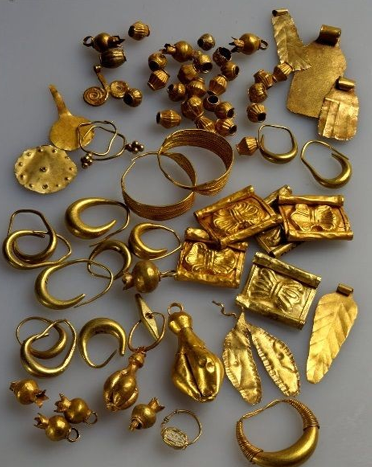Gold has fascinated humanity since ancient times. Its rarity, beauty, and malleability have made it a symbol of wealth, power, and divine connection across various cultures and civilizations. This blog explores the rich history and cultural significance of gold, from ancient times to the modern era, highlighting key periods and regions that have been shaped by this precious metal.
Ancient Civilizations and the Birth of Gold Worship
-
 Ancient Egypt
Ancient Egypt- Historical Significance: In ancient Egypt, gold was considered the flesh of the gods, especially the sun god Ra. It was used extensively in temples, tombs, and artifacts.
- Cultural Practices: Gold was used to craft elaborate jewelry, masks, and burial items for pharaohs. The famous death mask of Tutankhamun is a prime example of the craftsmanship and value placed on gold in Egyptian culture .
- Mesopotamia
- Historical Significance: Mesopotamian civilizations, such as the Sumerians and Babylonians, used gold for both ceremonial and practical purposes.
- Cultural Practices: Gold was used in religious artifacts and to adorn the statues of deities. The Royal Tombs of Ur have revealed spectacular gold jewelry and objects, indicating the metal’s importance in their society .
- Indus Valley Civilization
- Historical Significance: The Indus Valley Civilization, located in modern-day Pakistan and northwest India, was one of the earliest cultures to use gold in their jewelry.
- Cultural Practices: Gold beads, earrings, and necklaces have been discovered in archaeological sites, showcasing the advanced metallurgy and aesthetic sensibilities of the civilization .
Gold in Cultural and Religious Contexts
 Hinduism and Buddhism
Hinduism and Buddhism- Cultural Significance: In Hinduism, gold is associated with the goddess Lakshmi, the deity of wealth and prosperity. It is also used in various religious ceremonies and festivals.
- Religious Practices: Gold is used to adorn temples and deities. In Buddhism, gold is used in the construction of stupas and statues of the Buddha, symbolizing spiritual purity and enlightenment .
- Christianity
- Cultural Significance: Gold has been used extensively in Christian liturgical objects, church decorations, and religious icons.
- Religious Practices: Gold is seen as a symbol of divine light and is used to create chalices, crosses, and other sacred items. The Vatican holds an immense collection of gold artifacts that reflect the historical importance of gold in Christianity .
- Islam
- Cultural Significance: Gold is considered a symbol of paradise and eternal life in Islam. It is used in religious architecture and personal adornment.
- Religious Practices: The Dome of the Rock in Jerusalem is one of the most iconic examples of gold’s use in Islamic architecture. Gold jewelry is also commonly given as dowry in Islamic weddings .
Modern Times and the Economic Role of Gold
 Gold Standard
Gold Standard- Economic Significance: The gold standard was a system where a country’s currency or paper money had a value directly linked to gold. Countries agreed to convert paper money into a fixed amount of gold.
- Impact: The gold standard helped stabilize international currencies and facilitated global trade. Although it was abandoned in the 20th century, it laid the foundation for modern economic policies .
- Gold Reserves
- Economic Significance: Countries hold gold reserves as part of their central bank’s assets to secure their economies.
- Impact: Gold reserves act as a guarantee against economic instability and inflation. Major holders of gold reserves include the United States, Germany, Italy, France, and Russia .
Conclusion
The historical and cultural significance of gold is vast and varied, spanning ancient civilizations to modern economies. Its allure and value have shaped societies, driven conquests, and adorned some of the most significant religious and cultural artifacts throughout history. Understanding gold’s profound impact on human history underscores its continuing importance in today’s world.
For more information on gold prices and trends, visit the World Gold Council’s Gold Hub. To explore comprehensive gold statistics and information, the U.S. Geological Survey is an invaluable resource. For insights into gold coins and bullion, check out GovMint.com
 Hinduism and Buddhism
Hinduism and Buddhism Gold Standard
Gold Standard